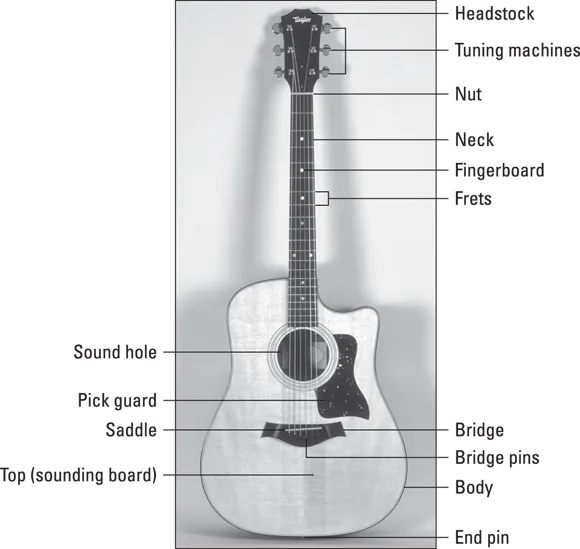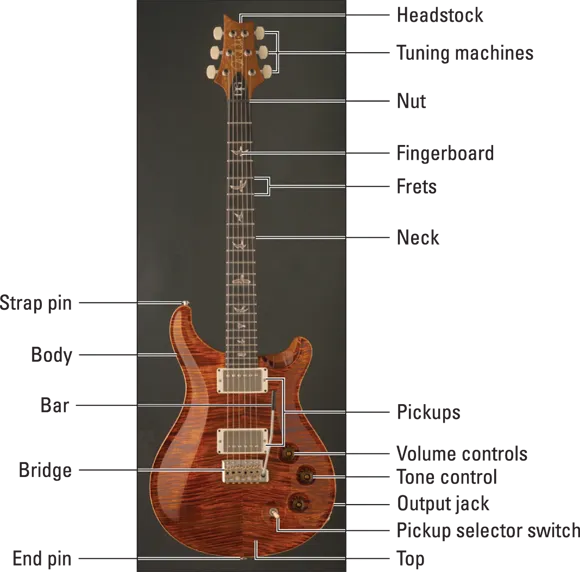
Guitar All-in-One For Dummies
Book + Online Video and Audio Instruction
Mark Phillips, Jon Chappell, Desi Serna
- English
- ePUB (mobile friendly)
- Available on iOS & Android
Guitar All-in-One For Dummies
Book + Online Video and Audio Instruction
Mark Phillips, Jon Chappell, Desi Serna
About This Book
A one-stop resourceto the essentialsofowning and playingtheguitar
If you've just bought a guitar, or you've had one for a while, you probably knowit takes some time and effort to learn how to play the popular instrument.There's so much to know about owning, maintaining, and playing a guitar. Where do youevenbegin?
In Guitar All-in-OneForDummies, a team of expert guitarists and music teachersshows youthe essentialsyou need to know aboutowningand playing a guitar.Frompicking your first notestoexploringmusic theory and composition, maintaining your gear, anddiving into the specifics ofgenres like blues and rock, this bookis a comprehensive and practical goldmine of indispensable info.
Created for the budding guitarist who wants all their lessons and advice in one place, the book will show you how to:
- Maintain, tune, and string your guitar, as well as decipher music notation and guitartablature
- Understandguitar theory, sounds and techniques to help youlearnnew songs andadd your style to classictunes
- Practice several popular genres of guitar music, including blues, rock, andclassical
- Access accompanying online video and audio instructional resources thatdemonstrate the lessonsyou find in the book
Perfect forguitar players at any skill level, Guitar All-in-OneForDummies is a must-have resource for anyone who wants togetthe mostoutoftheir own guitar and makegreat music.
Frequently asked questions
Information
Guitar 101
Contents at a Glance
- Chapter 1: Guitar Anatomy and Tuning
- The Parts and Workings of a Guitar
- How Guitars Make Sound
- Tuning Your Guitar
- Tuning Your Guitar to Itself
- Tuning Your Guitar to an External Source
- Chapter 2: Getting Ready to Play
- Assuming the Positions
- Getting Your Head Around Guitar Notation
- Discovering How to Play a Chord
- Chapter 3: Buying and Stringing a Guitar
- First Things First: Developing a Purchasing Plan
- Noting Some Considerations for Your First Guitar
- Sifting through Models to Match Your Style
- Looking for Quality
- Before You Buy: Walking through the Buying Process
- Changing Your Strings
- Stringing an Acoustic Guitar
- Stringing a Nylon-String Guitar
- Stringing an Electric Guitar
- Chapter 4: Deciphering Music Notation and Tablature
- Knowing the Ropes of Standard Music Notation
- Relating the Notes on the Staff to the Fretboard
- Relishing the Usefulness of Guitar-Specific Notation
Guitar Anatomy and Tuning






www.dummies.com/go/guitaraio/The Parts and Workings of a Guitar


- Back (acoustic only): The part of the body that holds the sides in place; made of two or three pieces of wood.
- Bar (electric only): A metal rod attached to the bridge that varies the string tension by tilting the bridge back and forth. Also called the tremolo bar, whammy bar, vibrato bar, and wang bar.
- Body: The box that provides an anchor for the neck and bridge and creates the playing surface for the right hand. On an acoustic, the body includes the amplifying sound chamber that produces the guitar’s tone. On an electric, it consists of the housing for the bridge assembly and electronics (pickups as well as volume and tone controls).
- Bridge: The metal (electric) or wooden (acoustic) plate that anchors the strings to the body.
- Bridge pins (acoustic only): Plastic or wooden dowels that insert through bridge holes and hold the strings securely to the bridge.
- End pin: A post where the rear end of the strap connects. On acoustic-electrics (acoustic guitars with built-in pickups and electronics), the pin often doubles as the output jack where you plug in.
- Fingerboard: A flat, plank-like piece of wood that sits atop the neck, where you place your left-hand (or right-hand, if you're playing a left-handed guitar) fingers to produce notes and chords. The fingerboard is also known as the fretboard, because the frets are embedded in it.
- Frets: Thin metal wires or bars running perpendicular to the strings that shorten the effective vibrating length of a string when you press down on it, enabling it to produce different pitches.
- Headstock: The section that holds the tuning machines (hardware assembly) and provides a place for the manufacturer to display its logo.
- Neck: The long, clublike wooden piece that connects the headstock to the body and holds the fretboard.
- Nut: A grooved sliver of stiff nylon or other synthetic substance that stops the strings from vibrating beyond the neck. The strings pass through the grooves on their way to the tuning machines in the headstock. The nut is one of the two points at which the vibrating area of the string ends. (The other is the bridge.)
- Output jack: The insertion point for the cord that connects the electric guitar (or acoustic guitar that has been fitted with a pickup) to an amplifier or other electronic device.
- Pickup selector (electric only): A switch that determines which pickups are currently active.
- Pickups: Barlike magnets that create the electrical current, which the amplifier converts into musical sound.
- Saddle: For acoustic, a thin plastic strip that sits inside a slot in the bridge; for electric, separate metal pieces that provide the contact point for the strings and the bridge.
- Sides (acoustic only): Separate curved wooden pieces on the body that join the top to the back.
- Strap pin: Metal post where the front, or top, end of the strap connects. (Note: Not all acoustics have a strap pin. If the guitar is missing one, tie the top of the strap around the headstock, above the nut.)
- Strings: The six metal (for electric and steel-string acoustic guitars) or...
